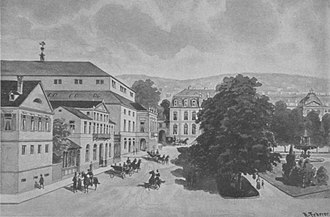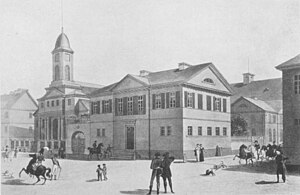Café Marquardt

The Café Marquardt , from 1887 Café Bechtel, was a popular social meeting place since 1844 on Palace Square in Stuttgart . The café emerged from two buildings built around 1808, the Vellnagel-Haus and the Danneckerei. After the café was demolished in 1893, the Olga building was built on the property, which was destroyed in the Second World War and replaced by a new building.
history
Vellnagel House
In 1807 King Friedrich von Württemberg gave his steward Bartholomäus Frasinelli a building site on the Schlossplatz in Stuttgart. On the corner property at Königstrasse 9 next to the St. Eberhard Cathedral, Frasinelli had Nikolaus Friedrich von Thouret build a representative, two-story house. In the 1830s, the director of the Hofbank, Johann Christian Carl von Vellnagel, acquired the building. It was named Vellnagel House after him.
|
|
Then mess
Johann Heinrich Dannecker , a sculptor with an international reputation, was the uncrowned king among the Stuttgart artists at the turn of the 19th century. King Friedrich gave him a building site on Schlossplatz next to Frasinelli's property. Dannecker's house was built according to his plans on Bolzstrasse between the Vellnagel house and the court theater and was inaugurated in May 1808. The two-story, seven-axis building, known as the “Danneckerei”, served as a residential building, studio, museum and art school and quickly became famous. Dannecker received many dignitaries, nobles and artists in his house, including artists of international renown such as Antonio Canova and Bertel Thorvaldsen . In 1815 King Friedrich even paid a visit to the Danneckerei with Tsar Alexander .
Café Marquardt
After Dannecker's death in 1841, the innkeeper Hermann took over the Danneckerei in 1842 and set up the Café Hermann. In 1844 Johann Christian Marquardt acquired the Café Hermann and the Vellnagel house. He and his son Ludwig Marquardt ran Café Marquardt in the two buildings for three decades. In 1855, Johann Christian Marquardt's brother Wilhelm Marquardt built the Hotel Marquardt on Königstraße across from Café Marquardt , which for decades was the first hotel on the square.
The literary association “ Die Glocke ” has been meeting in Café Hermann since it was founded in 1843. In 1844, the association built its own club premises on shares in the garden of Café Hermann, which was now called Café Marquardt. The restaurant consisted of a spacious hall with a vaulted ceiling in the style of old bellhouses.
Café Bechtel
In 1887 the chef Theodor Bechtel sold his house at Kronprinzstrasse 10, which had been in the family for three decades, and rented the Café Marquardt, which he continued as Café Bechtel. After the two café buildings were demolished in 1893, Bechtel opened a pastry shop and a café-restaurant at Schlossstrasse 12/14 (now Bolzstrasse), which his wife Karoline Bechtel continued to run after his death in 1898.
Theodor Bechtel also emerged as a cookbook author. Friederike Luise Löffler (1744–1805) had published a very successful cookbook in 1791, which was continued by her daughter Henriette Huttenlocher, née Löffler (1780–1848). In 1883 Theodor Bechtel published a revised version of the cookbook, which his son Eugen Bechtel, who was also a cook, continued from 1897.
In the preface to the cookbooks, father and son did not fail to point out their many years of expertise as chefs. Theodor Bechtel had "many years of experience as a practical cook at Hotel Klumpp zum Bären in Wildbad and for 25 years as a practicing cook in Stuttgart". Eugen Bechtel boasted of his work “as a volunteer in the royal court kitchen in Stuttgart”, as master chef “in the first mansions” and as cook and chef “in the finest hotels and restaurants”.
Olgabau
In 1893 the two café buildings were demolished. In its place, the neo-baroque Queen Olga Building was built in 1893–1895 , which was badly damaged in World War II and replaced by a new building in 1950–1954.
literature
- Friedrich Hackländer: The novel of my life. Volume 2. Stuttgart: Krabbe, 1878, pages 30-31.
- Henriette Löffler; Theodor Bechtel: Henriette Löffler's illustrated cookbook. Newly published and increased. Reprint of the 10th edition, Ulm 1883. Stuttgart: Deutscher Bücherbund, 1991. Original edition under the title: Henriette Löffler's large illustrated cookbook for simple tables and fine cuisine.
- Henriette Löffler; Eugen Bechtel: Löffler-Bechtel's large illustrated cookbook. Completely reworked. Ulm: Ebner, 1897.
- Adolf Spemann: Dannecker. Berlin: Spemann, 1909, pages 80-85.
- Gustav Wais: Old Stuttgart's buildings in the picture: 640 pictures, including 2 colored ones, with explanations of city history, architectural history and art history. Stuttgart 1951, pages 493, 592, 593, 597, 598.
- Martin Woerner; Gilbert Lupfer; Ute Schulz: Architectural Guide Stuttgart. Berlin: Reimer, 2006, page 8.
- Johannes Zahlten: The "Danneckerei". Künstlerhaus - collection of antiquities - place of pilgrimage. In: Christian von Holst (editor): Swabian classicism between ideal and reality, essays. Stuttgart: Staatsgalerie Stuttgart, 1993, pages 143–154.
Footnotes
- ↑ #Wais 1951.1 , page 493.
- ↑ # Spemann 1909 , # Paid 1993 .
- ↑ #Wais 1951.1 , page 593, 596th
- ↑ # Hackländer, 1878.2 .
- ↑ #Wais 1951.1 , page 598.
- ↑ # Löffler 1883 , # Löffler 1897 . - The cookbook in Baden 1770–1950, Friederike Luise Löffler .
- ↑ # Wörner 2006 .
Web links
Coordinates: 48 ° 46 ′ 46.2 " N , 9 ° 10 ′ 47.7" E


